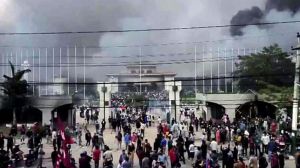The environment ministry’s expert appraisal committee (EAC) has cleared a proposal to construct a 118-metre high dam in the same place where a devastating glacial lake outburst flood (GLOF) ravaged parts of Sikkim and washed away a 60-metre-high rockfill concrete dam of the 1200-MW Teesta-III hydel project. The panel’s decision raises questions because the design of the new structure has not been cleared by the Central Water Commission, the Geological Survey and Central Soil and Materials Research Station. A public hearing has not been held to make sure the project addresses the concerns of local people.
Key Takeaways:
1. GLOFs are disaster events caused by the abrupt discharge of water from glacial lakes — large bodies of water that sit in front of, on top of, or beneath a melting glacier. As a glacier withdraws, it leaves behind a depression that gets filled with meltwater, thereby forming a lake.
2. The more the glacier recedes, the bigger and more dangerous the lake becomes. Such lakes are mostly dammed by unstable ice or sediment composed of loose rock and debris. In case the boundary around them breaks, huge amounts of water rush down the side of the mountains, which could cause flooding in the downstream areas — this is referred to as a GLOF event.
3. GLOFs can be triggered by various reasons, including glacial calving, where sizable ice chunks detach from the glacier into the lake, inducing sudden water displacement. Incidents such as avalanches or landslides can also impact the stability of the boundary around a glacial lake, leading to its failure, and the rapid discharge of water.
4. GLOFs can unleash large volumes of water, sediment, and debris downstream with formidable force and velocity. The floodwaters can submerge valleys, obliterate infrastructure such as roads, bridges, and buildings, and result in significant loss of life and livelihoods.
Story continues below this ad
| International Year of Glaciers’ Preservation |
| The United Nations has declared 2025 as the International Year of Glaciers’ Preservation to raise awareness about the significance of preserving glacier health in a warming world. Also, starting in 2025, March 21 will be marked annually as the World Day of Glaciers. |
Reports highlighting the vulnerability around GLOF
1. According to a report published by the Indian Space Research Organisation (ISRO) last year, 676 of the 2,431 glacial lakes larger than 10 hectares in the Himalayas have notably expanded since 1984. Of these, 130 lakes are in India, with seven (7), fifty-eight (58), and sixty-five (65) in the Ganga, Brahmaputra, and Indus river basins, respectively.
2. The report noted that 601 lakes have more than doubled in size, 10 have grown between 1.5 to 2 times, and 65 lakes have expanded by 1.5 times. An elevation-based analysis reveals that 314 lakes are located between 4,000 and 5,000 metres, and 296 lakes are above 5,000 metres in elevation.
3. The Ghepang Ghat glacial lake in the Indus River Basin, situated at an elevation of 4,068 metres in Himachal Pradesh, has seen a 178 per cent increase in size from 36.49 to 101.30 hectares between 1989 and 2022.
4. According to a study, ‘Enhanced Glacial Lake Activity Threatens Numerous Communities and Infrastructure in the Third Pole’, published in the journal Nature in 2023, since 1980, in the Himalayan region, particularly in southeastern Tibet and the China-Nepal border area, GLOFs have become more frequent.
Story continues below this ad
5. “Approximately 6,353 sq km of land could be at risk from potential GLOFs, posing threats to 55,808 buildings, 105 hydropower projects, 194 sq km of farmland, 5,005 km of roads, and 4,038 bridges in the region.”
6. Another analysis, ‘Glacial Lake Outburst Floods Threaten Millions Globally’, published in the journal Nature in February 2023, showed that about 3 million people in India and 2 million in Pakistan face the risk of GLOFs.
While the number and size of glacial lakes in these areas (India and Pakistan) isn’t as large as in places like the Pacific Northwest or Tibet, it’s that extremely large population and the fact that they are highly vulnerable that mean Pakistan and India have some of the highest GLOF danger globally.
Tom Robinson, co-author of the study
7. According to the State of the Cryosphere 2024 – Lost Ice, Global Damage, a report released at the United Nations Climate Change Conference in Baku, Azerbaijan (November 11-22, 2024), stated that due to rising temperatures, record glacier melting has occurred in 2023 globally, including in Asia and the Indian Himalayan Region is among the regions directly affected by these changes.
BEYOND THE NUGGET: Situation in Uttarakhand
1. Recently, the Uttarakhand government has constituted teams of experts to evaluate the risk posed by five potentially hazardous glacial lakes in the region. These lakes are prone to Glacial Lake Outburst Floods (GLOFs), the kind of events that have resulted in several disasters in the Himalayan states in recent years.
Story continues below this ad
2. Uttarakhand has witnessed two major GLOF events in the past few years. The first took place in June 2013, which affected large parts of the state — Kedarnath valley was the worst hit, where thousands of people died. The second occurred in February 2021, when Chamoli district was hit by flash floods due to the bursting of a glacier lake.
3. These glacial lakes have been categorised into three risk levels: ‘A’, ‘B’, and ‘C’. Five highly sensitive glacial lakes fall into the ‘A’ category. These include Vasudhara Tal in the Dhauliganga basin in Chamoli district, and four lakes in Pithoragarh district — Maban Lake in Lassar Yangti Valley, Pyungru Lake in the Darma basin, an unclassified lake in the Darma basin, and another unclassified lake in Kuthi Yangti Valley.
4. The rising surface temperatures could worsen the situation in Uttarakhand. The state’s annual average maximum temperature may increase by 1.6-1.9 degree Celsius between 2021-2050, according to a 2021 study, ‘Locked Houses, Fallow Lands: Climate Change and Migration in Uttarakhand, India’, carried out by the Germany-based Potsdam Institute for Climate Research (PIK) and The Energy and Resources Institute (TERI) in New Delhi. This could exacerbate the risk of GLOFs in the state.
(Source: Govt to launch survey to assess vulnerability of glacial lakes after monsoon, Why Uttarakhand govt wants to evaluate the risk of Glacial Lake Outburst Floods, 14 months after glacial lake flood, Sikkim’s Teesta dam gets environment nod for rebuild without public hearing, Hindu Kush Himalaya faces increased risks amid record glacier melting)
Story continues below this ad
Subscribe to our UPSC newsletter. Stay updated with the latest UPSC articles by joining our Telegram channel – IndianExpress UPSC Hub, and follow us on Instagram and X.
🚨Union Budget 2025 special: Click Here to read the February 2025 issue of the UPSC Essentials monthly magazine. Share your views and suggestions in the comment box or at manas.srivastava@indianexpress.com🚨


































